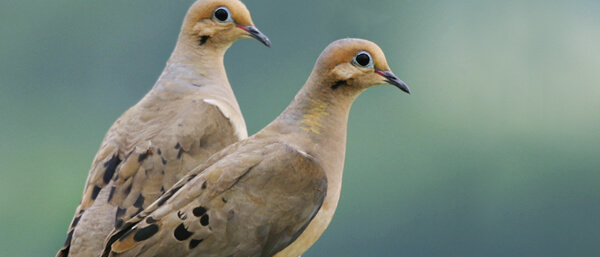Bird Conservation Group Hails Iowa DNR Decision Prohibiting Use of Lead Shot for Dove Hunting
MEDIA RELEASE
Contact: Robert Johns, 202-234-7181 ext.210,
 |
| Mourning Doves by Gary Smyle |
(Washington, D.C., Over 500 scientific studies attest to the fact that IOWA DNR did the right thing in taking action that will reduce the proliferation of one of the world’s most toxic substances – lead. Tens of thousands of doves and other birds mistakenly ingest lead shot littering the ground after the hunting season. Every Mourning Dove that ingests a lead pellet is essentially a dead dove. The use of nontoxic shot will save these birds from needless and agonizing deaths from toxic lead left in fields. The Iowa decision is pro-wildlife and it is pro-environment,” said ABC President George Fenwick. "Contrary to what members of the gun lobby may say, this action is not anti-hunting. Hunters can still engage in a pastime that has been part of our culture for hundreds of years. The only change is that they need to use non-toxic ammunition,” said Fenwick. In 2010 the price of steel shotgun ammo for doves went on sale, and was actually lower than the price of steel shot. The non-toxic shot requirement follows several discussions by the commission during the past year concerning the impacts of lead shot to the environment and on wildlife. Lead – or toxic – shot used in hunting can be ingested by wildlife. There has been a national ban on the use of lead shot for waterfowl hunting since 1991 with non-toxic shot for waterfowl being in place in Iowa since 1987. The rules approved by the commission allow for a dove season starting Sept. 1st and ending Nov. 9th. The final rule allows the harvest of 15 doves a day and can be either mourning or Eurasian collared-doves. The possession limit is 30 and the season is open state-wide. Commissioners added and approved an amendment on Thursday that would require hunters to only use non-toxic shot while hunting doves anywhere in the state of Iowa. According to Iowa DNR, he decision to ban toxic shot for dove hunting was based largely on the fact that much of the hunting occurs over a small area which would increase the likelihood of lead concentrations being created. A series of recent developments on the issue of lead ammunition continues to bolster the case against continued use of lead ammunition for both shotguns and rifles, including editorials by leaders in the hunting and fishing community, findings from several new studies, and actions by the U.S. military. Ted Williams, editor of Fly Rod and Reel Online, said in Audubon Magazine that: “Despite cheap available alternatives most American sportsmen are still using lead ammunition and fishing tackle. Because of this, some of our most majestic birds, from eagles to loons to condors pay a terrible price.” In addition, one of the world’s leading newspapers, the New York Times, has also called for an end to lead ammunition use in hunting. A Another development impacting the continued use of lead ammunition is a decision by the U.S. Army to move to a lead-free 5.56mm rifle bullet. Lt. Col. Jeff Woods, the Army's small caliber Ammunition Product Manager, was effusive in his praise of its performance in the May issue of www.Military.com. "There's nothing out there right now that can perform like this round on this wide a range of targets. This is a clear case where making something environmentally friendly works for us," he said. Army officials said the new ammunition improved hard-target capability and provided more dependable, consistent performance at all distances, as well as improved accuracy, reduced muzzle flash, and increased velocity. “Clearly, the military praise of the performance of this lead-free ammunition speaks for itself. I doubt that there are any more knowledgeable people when it comes to understanding and appreciating ammunition performance, than the military. The myth that lead-free ammunition doesn’t perform has been exposed, and hunters can use non-toxic ammunition with confidence that it will meet their high standards,” Fenwick said. Several studies of various species of birds suggest that up to 10 million birds and other animals die each year from lead poisoning in the United States, including Bald Eagles, Golden Eagles, Loons, Trumpeter Swans, and doves. This occurs when animals scavenge on carcasses shot and contaminated with lead bullet fragments, or pick up and eat spent lead shot pellets or lost fishing weights, mistaking them for food or grit. Some animals die within days, while others suffer for years from lead’s debilitating effects. Lead ammunition also poses health risks to people. Lead bullets fragment on impact into minute particles, spreading throughout game meat that people eat. X-ray studies show that hundreds of dust-sized lead particles can contaminate meat more than a foot and a half away from the bullet track. A recent study found that up to 87% of game killed by lead ammunition contains unsafe levels of lead when consumed by pregnant women or children. Nearly ten million hunters, their families, and low-income beneficiaries of venison donations may be at risk. |


















































